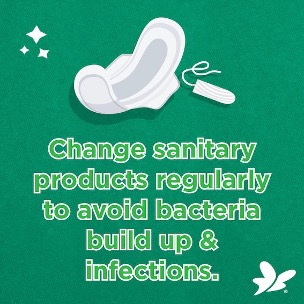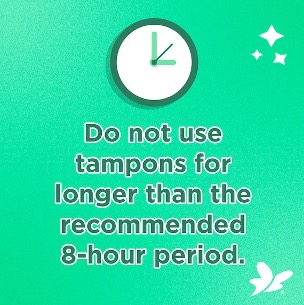How Often Should You Change Your Sanitary Options?
How often you change your sanitary options all depends on your flow, or the activity you wish to do. When to use a tampon, pad or pantyliner, will also vary between each woman’s own preferences. It’s also important to note that you shouldn’t feel you have to stick to only one sanitary option during your cycle. You can swap and change your sanitary items as need be, at various stages of your flow. You might even want to put together a small sanitary kit with all your favourite Stayfree items and keep it in your handbag, car or office draw. This way you’ll be protected and prepared, no matter what comes your way.
change-sanitary-pad.jpeg

During light to regular flow
Regular tampons and pads
When a tampon hurts you, it might be because there isn’t enough moisture and your flow is too light.¹ This would cause inserting anything to be uncomfortable and difficult to accomplish. However, when your flow is regular or at its lightest, then Stayfree Procomfort regular tampons might be the best option for you.
The tampon will have enough moisture to be inserted comfortably, avoiding any discomfort caused by dryness.
Although some women might have a light enough flow to be able to leave your tampon in for up to eight hours, it’s better to change them more regularly. In most cases, you’ll want to change your tampon every four to six hours - four hours for a heavier flow, and six hours for a light to regular flow.
Stayfree Maxi Thick regular pads can be a great alternative way to stay protected without inserting anything. You might also prefer using pads if you are still figuring out your flow, if you aren’t quite comfortable using a tampon yet, or you simply prefer pads to tampons - it’s all about preference.
It’s recommended to change your pad at least once every eight hours, around three times a day. If you are exercising with a pad, be sure to change it straight after to avoid any bacterial infections.
During heavy flow
Super tampons and pads
Stayfree Procomfort super tampons are great if you are at the start of your period, have a heavy flow in general, or if you just want to be extra safe and secure. Even though they are larger in size than regular tampons, they are still just as safe to use as regular tampons, even for first-timers. If you experience any discomfort then your flow might be too light for super tampons. In this case, you should switch to a regular tampon. Just like any other tampon, you should change it at least every four to eight hours.
Stayfree Maxi Thick super pads are 20% longer which means they are great for those with a heavy flow who want to ensure they are protected against leakage and stains. Not only do they provide you with the best protection against leakage, but they’re comfortable, too. During the day, you’ll need to change your pad just as often as you would any other pad. In the case where your flow doesn’t seem to match the pad you’ve chosen, Stayfree has many options available, so that you can find the one that best suits you.
Pantyliners
Designed with breathable cotton, Stayfree Everyday pantyliners are a great way to stay fresh and dry when spotting, during ovulation or when experiencing any discharge throughout other days of your cycle. These are especially effective when you know your period is coming, but you aren’t sure when exactly it will arrive. They will be light enough to keep you protected, and thin enough that you hardly notice them. For this reason, they can be worn outside of your cycle, too. You should change pantyliners every three to four hours to make sure you’re kept fresh all day.
don-t-use-tampon-long.jpeg

When you sleep
Regardless of how light or heavy your flow is when you sleep, you’re more at risk of finding stains on your bed the next morning because of the angle your body is at when you’re lying down.
When you sleep, your flow is directed downwards, so you’ll want to switch to Stayfree Bodyfit Ultra night pads which are made to be extra long, wide and absorbent, designed to redirect it before it gets to your sheets. It’s also designed with bodyfit technology, meaning that it will fit your body perfectly - even when you sleep.
Toxic shock syndrome (TSS) occurs when harmful bacteria enter the body and releases toxins.²
This can occur, in rare cases, when sanitary products aren’t replaced regularly enough.
Although it’s safe to sleep with a pantyliner, tampon or pad, you should change all your sanitary items as often as is required to stay clean and dry. When it comes to wearing tampons at night, you can put one in before you go to bed and remove it first thing in the morning to avoid TSS. If you still feel unsure, you can always look to our instructions on the tampon package insert for more guidance.
Preference and what’s required of your sanitary options
Lastly, you might also want to change your sanitary options based on your workouts and activities, or simply because you prefer certain sanitary options over others. In addition, when using any sanitary item, pay attention to your flow and change it if you feel that it’s too heavy or too light for the one that you are using.
Sources:
- [1] https://www.healthline.com/health/do-tampons-hurt
- [2] https://www.nhs.uk/conditions/toxic-shock-syndrome/#:~:text=Toxic%20shock%20syndrome%20(TSS)%20is,age%20%E2%80%93%20including%20men%20and%20children
